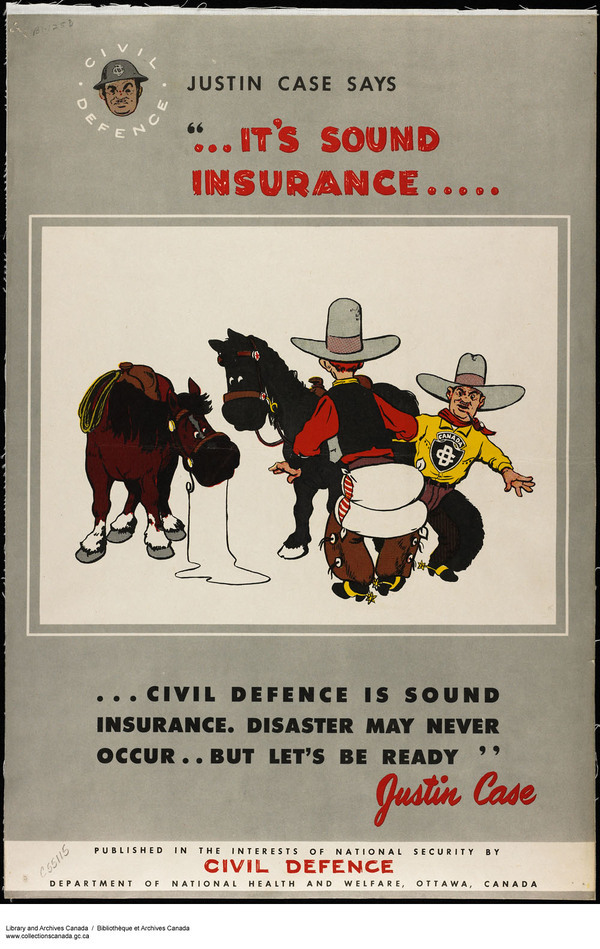Justin Case - The Post War Masculine Ideal
One can see a similar dichotomy between the “good” and “bad” citizen in the graphic illustrations of Justin Case and the red-haired man [Figures 2, 3, 6 and 9]. These characters provide cues as to desired forms of masculinity. As Dummitt (2007) argues, post war Canadian masculinities reflected Western norms of rationality, reasonability, and objectiveness.[41] Such traits reflected those characteristics of “good” citizens, a universalizing personhood that obscures gender while still performing it.[42] In this caricature, the “illogical, emotional, or hysterical” woman was the antithesis of the rational man.[43]
In the poster series, Justin Case is depicted as being in control, calmly assessing each risky situation and drawing on his preparedness skills to take the right action. His objectivity is contrasted by the behaviours of the red-haired man, who often appears to be absent-minded, irrational, and oblivious (sleeping under a coconut tree in Figure 3, for example). Masculine ideals paralleled the modern emphasis on rationality and progress, with unintended and complex consequences. Some argue that middle-class domestic aspirations robbed men of a perceived “rugged masculinity.”[44] This paradox is communicated graphically in the poster depicting Justin and his counterpart about to mount horses [Figure 9]. Justin’s confidence is a stark contrast to his companion who has a pillow tied to his backside in anticipation of falling off. Whereas Justin seems to have mastered the dichotomy between domestication and wildness, comfortable with all the tasks that might be required of the masculine ideal in a civil defence crisis, the red-haired man is depicted as the antithesis of bravery, capability, and resilience.
Like the relationship between Bea and the blond woman, Justin’s facial characteristics reveal him as the red-haired man’s senior. He often performs the role of an advisor, which could be interpreted as paternalistic or fatherly. Furthermore, their age difference may imply something about the histories of these two men.[45] In the postwar climate, the male veteran was often considered the pinnacle of Canadian society, their military service framed as the ultimate service to the country and an act of exemplary citizenship.[46] Since the Bea Alerte and Justin Case poster series was created in the early 1950’s and circulated for a number of years, the red-haired man may have been too young to have fought in World War II. Justin Case, on the other hand, could speculatively be old enough to be a veteran of the either the first or second World Wars, further cementing his status as embodying many of the ideals of normative masculinity during the postwar period in Canada.
References
41 Dummit, 2.
42 Ibid., 17.
43 Ibid., 2.
44 Ibid., 5.
45 Robert Rutherdale, “New 'Faces' for Fathers: Memory, Life-Writing, and Fathers as Providers in the Postwar Consumer Era,” in Creating Postwar Canada: Community, Diversity, and Dissent, 1945-75, ed. Magda Fahrni and Robert Rutherdale (Vancouver: UBC Press, 2008), 241-267.
46 Dummitt, 30.
